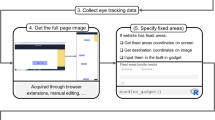Abstract
Adaptive human–computer interfaces (HCIs) are fundamental to designing adaptive websites and adaptive decision support systems. Integrating these intelligent systems with modern eye trackers provides more effective ways to exploit eye fixation data and offers improved services to users. We develop an exemplar-based classifier using the tabu search algorithm to predict which decision strategy may underlie an empirical search behavior. Our algorithm reduces the size of decision concept representations to find the best exemplars for each concept. Experimental results show that our classifier is highly accurate in classifying the sequence of empirical eye fixations, demonstrating the promise of integrating adaptive HCIs with modern eye trackers.


Similar content being viewed by others
References
Aha DW, Kibler D, Albert MK (1991) Instance-based learning algorithms. Mach Learn 6(1):37–66
Bettman JR, Johnson EJ, Payne JW (1990) A componential analysis of cognitive effort in choice. Organ Behav Hum Decis Process 45:111–139
Brandt SA, Stark LW (1997) Spontaneous eye movements during visual imagery reflect the content of the visual scene. J Cogn Neurosci 9(1):27–38
Brusilovsky P (2001) Adaptive hypermedia. User Model User Adapt Interact 11(1–2):87–110
Chen Q (2001) Human computer interaction: issues and challenges. IGI Global, Hershey
Cover TM, Hart PE (1967) Nearest neighbor pattern classification. IEEE Trans Inf Theory 13(1):21–27
Day R-F (2010) Examining the validity of the Needleman–Wunsch algorithm in identifying decision strategy with eye-movement data. Decis Support Syst 49(4):396–403
Dix A (2009) Human–computer interaction. Springer, Berlin
Dorigo M, Gambardella LM (1997) Ant colony system: a cooperative learning approach to the traveling salesman problem. IEEE Trans Evol Comput 1(1):53–66
Glover F (1989) Tabu search—part i. ORSA J Comput 1:190–206
Glover F (1990) Tabu search—part ii. ORSA J Comput 2:4–32
Glover F, Laguna M (1997) Tabu search. Kluwer Academic Publishers, Dordrecht
Glover F, Hanafi S (2010) Metaheuristic search with inequalities and target objectives for mixed binary optimization part i: exploiting proximity. Int J Appl Metaheuristic Comput 1(1):1–15
Glover F, Hanafi S (2010) Metaheuristic search with inequalities and target objectives for mixed binary optimization—part ii: exploiting reaction and resistance. Int J Appl Metaheuristic Comput 1(2):1–17
Glover F, Laguna M, Marti R (2000) Fundamentals of scatter search and path relinking. Control Cybern 29(3):653–684
Hair JF, Anderson RE, Tatham RL, Black WC (1998) Multivariate data analysis, 5th edn. Prentice-Hall, London
Hegarty M, Mayer RE, Green CE (1992) Comprehension of arithmetic word problems: evidence from students’ eye fixations. J Educ Psychol 84(1):76–84
Holland JH (1975) Adaptation in natural and artificial systems: an introductory analysis with applications to biology, control, and artificial intelligence. University of Michigan Press, Ann Arbor
Just MA, Carpenter PA (1976) Eye fixations and cognitive processes. Cogn Psychol 8:441–480
Kirkpatrick S, Gelatt C Jr., Vecchi M (1983) Optimization by simulated annealing. Science 220(4598):671–680
Laeng B, Teodorescu D-S (2002) Eye scanpaths during visual imagery reenact those of perception of the same visual scene. Cogn Sci 26:207–231
Laguna M, Marti R (2003) Scatter search: methodology and implementations in C. Kluwer Academic Publishers, Boston
Levenshtein VI (1966) Binary codes capable of correcting deletions, insertions, and reversals. Sov Phys Dokl 10:707–710
Lin C-C (2006) Optimal web site reorganization considering information overload and search depth. Eur J Oper Res 173(3):839–848
Mantaras RLD, Armengol E (1998) Machine learning from examples: inductive and lazy methods. Data Knowl Eng 25(1–2):99–123
Maquera G, Laguna M, Gandelman DA, Sant’Anna AP (2011) Scatter search applied to the vehicle routing problem with simultaneous delivery and pickup. Int J Appl Metaheuristic Comput 2(2):1–20
Medin DL, Smith EE (1984) Concepts and concept formation. Annu Rev Psychol 35:113–138
Payne JW, Bettman JR, Johnson EJ (1993) The adaptive decision maker. Cambridge University Press, New York
Perkowitz M, Etzioni O (2000) Towards adaptive web sites: conceptual framework and case study. Artif Intell 118(1):245–275
Picard RW (1997) Affective computing. MIT Press, Cambridge
Pomplug M, Sichelschmidt L, Wagner K, Clermont T, Rickheit G, Ritter H (2001) Comparative visual search: a difference that makes a difference. Cogn Sci 25:3–36
Qahri Saremi H, Abedin B, Meimand Kermani A (2008) Website structure improvement: quadratic assignment problem approach and ant colony meta-heuristic technique. Appl Math Comput 195(1):285–298
Rayner K (1998) Eye movements in reading and information processing: 20 years of research. Psychol Bull 124(3):372–422
Russo JE (2010) Eye fixations as a process trace. In: Schulte-Mecklenbeck M, Kuehberger A, Ranyard R (eds) A handbook of process tracing methods for decision research: a critical review and user’s guide. Taylor & Francis, Hove
Russo JE, Rosen LD (1975) An eye fixation analysis of multialternative choice. Mem Cogn 3(3):267–276
Smith EE, Medin DL (1981) Categories and concepts. Harvard University Pres, Cambridge
Todd P, Benbasat I (1991) An experimental investigation of the impact of computer based decision aids on decision making strategies. Inf Syst Res 2(2):87–115
Todd P, Benbasat I (1992) The use of information in decision making: an experimental investigation of the impact of computer-based decision aids. MIS Q 16(3):373–393
Todd P, Benbasat I (1994) The influence of decision aids on choice strategies: an experimental analysis of the role of cognitive effort. Organ Behav Hum Decis Process 60:36–74
Todd P, Benbasat I (2000) Inducing compensatory information processing through decision aids that facilitate effort reduction: an experimental assessment. J Behav Decis Mak 13(1):91–106
Vertegaal R (2003) Attentive user interfaces. Commun ACM 46(3):30–33
West JM, Haake AR, Rozanski EP, Karn KS (2006) Eyepatterns: software for identifying patterns and similarities across fixation sequences. In: Proceedings of the 2006 symposium on Eye tracking research & applications New York, pp 149–154
Wilson DR, Martinez TR (2000) Reduction techniques for instance-based learning algorithms. Mach Learn 38(3):257–286
Yin P-Y, Guo Y-M (2013) Optimization of multi-criteria website structure based on enhanced tabu search and web usage mining. Appl Math Comput 219(24):11082–11095
Acknowledgments
This research is partially supported by National Science Council of ROC, under Grants NSC 98-2410-H-260-018-MY3 and NSC 97-2410-H-218-022-.
Author information
Authors and Affiliations
Corresponding author
Rights and permissions
About this article
Cite this article
Yin, PY., Day, RF. & Wang, YC. Tabu search-based classification for eye-movement behavioral decisions. Neural Comput & Applic 29, 1433–1443 (2018). https://doi.org/10.1007/s00521-016-2583-2
Received:
Accepted:
Published:
Issue Date:
DOI: https://doi.org/10.1007/s00521-016-2583-2




